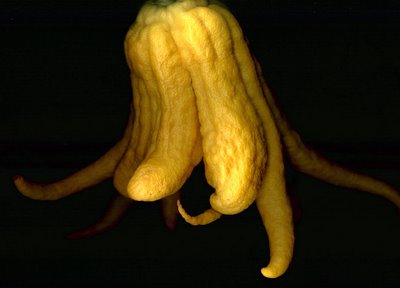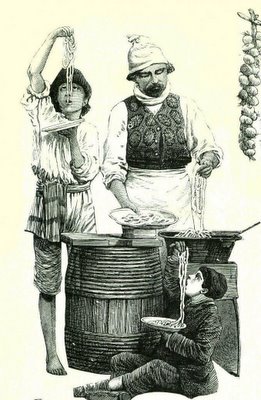 I started out
I started out with five little red eggplants, each just about the size and shape of an egg.
The constraints I faced in coming up with a recipe were that on the one hand, I wanted to preserve to the extent possible their
amazing shape and color, and on the other hand, I had been warned that this variety of eggplant requires
lots of cooking to tame its wild bitterness.
As soon as I cut them open I could tell that they were very intensely flavored.
They had a much more concentrated eggplanty aroma than your usual eggplant.
I cut off the tops on the bias and trimmed their adorable little stems with garden shears so each eggplant had a mini-beret.
Then I scooped out the insides and salted the shells and innards and let them rest. I tried to remove as many of the very tough seeds as possible.
One of the eggplants had some dark spots inside, but I was able to reach and remove them with my very tiny melon-baller. About twenty years ago I came across this gadget, which makes melon balls the size of a pea, and I just knew that the day would come when I would need exactly such an implement.
I cooked the shells and insides over high heat in a fairly prodigal amount of olive oil. Then I removed the eggplant from the skillet and cooked one diced onion, three large cloves minced garlic, a very small diced sweet pepper, a tomato, the eggplant innards, and a tiny bit of a hot pepper.
You may have noticed by now that I very seldom dice or mince onions and garlic. I usually prefer to make pretty thin slices for a more interesting flavor, but I thought a dice would be more amenable for the eggplant filling. I mixed the cooked diced vegetables with about a half cup each of toasted whole wheat breadcrumbs and grated parmesan (two ounces crumbs and about one ounce cheese), two tablespoons toasted pine nuts, two good pinches crumbled oregano (1/4 teaspoon), lots of black pepper, and four sprigs minced parsley (1/4 cup). I spooned the filling into the eggplant shells. You can probably skip this next step, but I wanted to give the little guys a cozy medium in which to simmer, so I sliced another onion and tomato (slices this time) and cooked them in some of the remaining oil. I had a head of garlic with tiny little cloves, so I left those whole. Then I nestled the stuffed eggplants, each jauntily sporting a mini-beret, among the stewed tomatoes and onions, and let them bake in a moderate oven for about an hour. There was enough filling remaining to stuff three tomatoes, who went along into the skillet. I tried to make some pictures, but they all just looked red. It was lovely though. The vivid wild flavors of the eggplants came through beautifully, but were not overwhelmingly bitter. I do recommend cooking this variety of eggplant if you find them. Just be prepared to give them enough time and olive oil.
Here’s a summary of the recipe:
The eggplants
5 to 10 little red eggplants (I had five, the recipe would have filled ten)
kosher salt
1 prodigal amount of olive oil (about 10 to 12 ounces, I think)
The filling
1 medium onion, diced
1 very small sweet pepper, diced (or 1/3 to 1/2 of a regular bell pepper)
3 large cloves garlic, finely minced
1 very small hot pepper, finely minced
1 peeled seeded tomato, or insides of two seeded tomatoes
Cooked innards from the eggplants, diced
2 ounces toasted crumbs from whole-grain bread
1 ounce grated parmesan
2 tablespoons toasted pine nuts (optional)
¼ teaspoon crumbled oregano
¼ cup minced parsley
black pepper
The ambient vegetables
1 onion, sliced into thin half-moons
1 tomato, sliced
1/2 very small sweet pepper, thinly sliced
5 very small cloves garlic
Scoop out the eggplants, salt lavishly, and allow to drain for an hour or so. Gently squeeze and pat them dry. Cook the shells, tops, and innards in oil in a cast iron skillet over high heat. Remove eggplants from oil and set aside.
Strain the remaining oil. Pour half of the oil back into the skillet and set over low heat. Add the diced onion. When the onion becomes transparent, add the peppers and garlic. Continue cooking until the garlic becomes fragrant and add the tomato and cook for a few more minutes.
In a bowl, combine the crumbs, cheese, oregano and pepper. Mix in the diced vegetables and add parsley and pine nuts. Spoon the filling into the eggplant shells. Spoon extra filling into tomato shells.
Heat oven to 350
Pour the remaining oil into the skillet. Cook the onion slices over low heat until they become transparent. Add the garlic cloves, pepper slivers and tomato and cook for 15 minutes longer. Gently place the filled eggplants and other filled vegetables into the skillet and set in the oven. Allow to bake for one hour, basting with the pan juices once or twice.
These went very nicely with the rice with spinach on page 462 of Claudia Roden’s Book of Jewish Food.




























